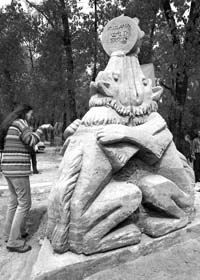The beach was bustling with activity as four dozen sand sculpture lovers from five countries presented their technically elaborate but short-lived creations. After schmoozing with the architects (no exaggeration, as many of the competitors are student architects and accomplished artists), this author learned that it takes an average of 15 tons of sand and five days of intensive work to build one sculpture. Normally two or three days would have been enough, if it weren’t for the May weather that unleashed rains and wind on Kyiv during the entire week. The competition organizers had 300 tons of sand delivered to the beach from a nearby sandpit. Sand sculpture was a first for many of the participants, so they spent the first day studying the material and getting the hang of it. From this point it was a matter of ordinary architectural technique, much like working stone, chiseling it away chip by chip. Twin brothers Yehor and Mykyta Zyhura revealed their own specialties. Since their favorite materials are clay and playdough, they used clayey sand to make their sculpture. That accounts for the fact that their “Mountain Shepherd,” a massive head with a reed pipe, does not have a very sandy complexion. “No, we didn’t mix anything into the sand. We only used a lot of water to pack the sand down. It’s all a matter of skill; there are no tricks involved,” Mykyta said while putting the finishing touches. The future architect’s diligence was understandable, since he was cleaning up the image of none other than himself: Mykyta and Yehor created their own self-portrait in sand. Incidentally, before the brothers added the bottom part of the face with its goatee, most people would mistake it for a likeness of the Ukrainian prize-winning singer Ruslana because of its upturned nose and long hair. “Why all this effort? To win the competition, of course.” Indeed, their six-foot head deserved to win. Smiling visitors posed next to sand sculptures of MTV’s Beavis and Butt-Head. The stars of the animated comedy show were the only painted sculptures and were truly colorful.
Sculptures by the Chinese participants had great youth appeal, like their “Chinese Deejay” spinning his vinyl records with oversized hands. Other competitors built a monument to a deejay turntable without the deejay. Some artists added adhesive materials to the sand, while others worked with ordinary sand without clay admixtures. Victory was claimed by a sculpture dedicated to Ruslana, which is no surprise. The sculpture, entitled “Wolverine Song” and featuring “wild wolves” holding the emblems of Eurovision and Ruslana above their heads, deserved to win. This three-meter composition kept its creators, Liudmyla Mysko, Tetiana Dreyeva, and Tetiana Ilyina, working for five days. The real Ruslana loved the winning sculpture and posed for photos next to it, signing autographs. The jury is traditionally headed by the famous architect, Oleh Pinchuk. The three female architects’ winning sculpture demonstrated brilliant execution and their ability to convey Eurovision aesthetics. Weather permitting, the sculptures will remain on display until the end of the Eurovision song contest. Admittance to the exposition is free.









